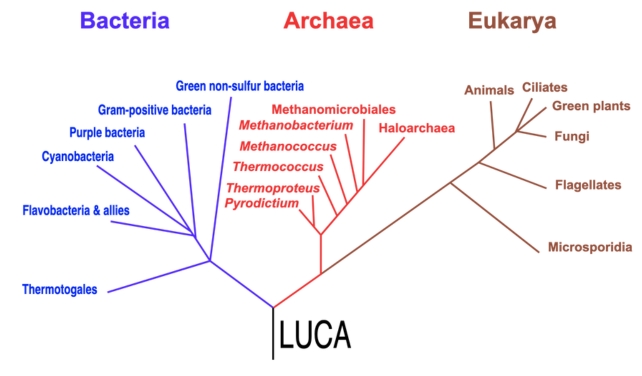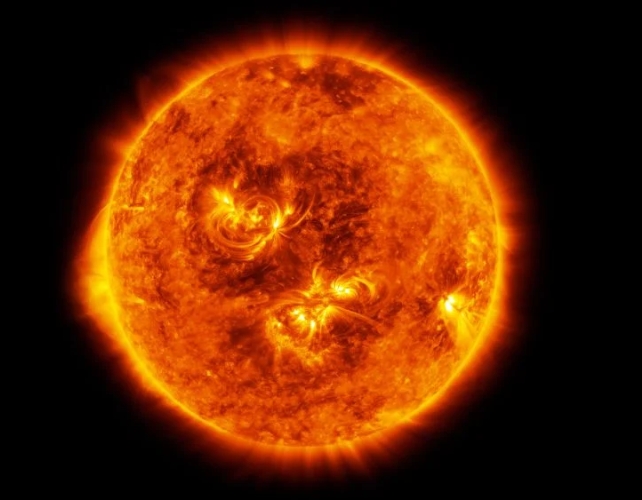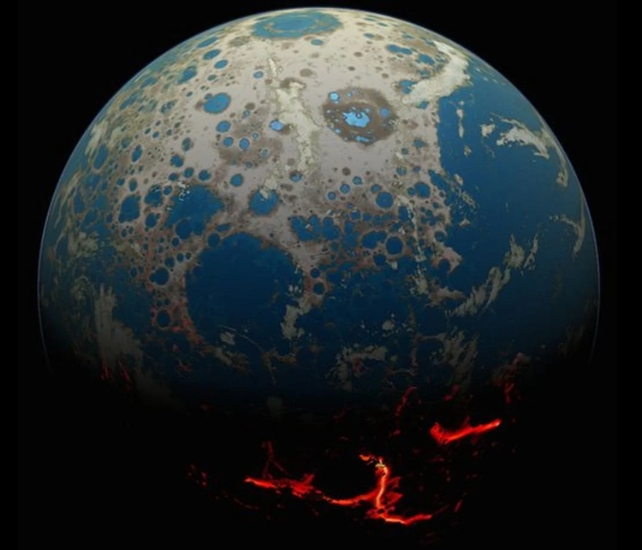At some early point in Earth's history, a collection of increasingly complex chemicals performed a new trick.
They somehow transformed themselves, with help from a jolt of energy, into an energy-producing and self-replicating cell. The timing of this critical moment in Earth's history is hidden behind the passing of billions of years.
Science has uncovered evidence of life as long ago as 4.2 billion years, only about 250 million years after the planet formed. Ancient fossilized microbial mats of cyanobacteria called stromatolites date back 3.7 billion years.
Ancient Australian rocks have isotope signatures suggestive of life that date back to 4.1 billion years ago. Filamentous structures found in ancient Canadian rocks could be biotic in origin and date back to 4.28 billion years ago.
Other scientists work on genetics to understand Earth's first life. They use the concept of the Last Universal Common Ancestor (LUCA) to try to understand life's trajectory.
LUCA is a hypothesized ancestral cell that was the forerunner of bacteria, archaea, and eukarya. LUCA is at least 3.6 billion years old, and possibly as old as 4.3 billion years.

There's still a lot of scientific discussion about the evidence for the earliest life on Earth. The exact timing of life's appearance is still being debated and determined.
However, despite the questions about the timing, one thing has become more clear: it happened quickly, not too long after the planet formed.
In a new paper, American astronomer David Kipping analyzes the evidence for rapid abiogenesis on Earth and other Earth-like planets. It's titled "Strong Evidence That Abiogenesis Is a Rapid Process on Earth Analogs." The paper has been accepted for publication in the journal Astrobiology.
"For the first time, we have formally strong evidence that favours the hypothesis that life rapidly emerges in Earth-like conditions." - David Kipping, Columbia University
"The early start to life naively suggests that abiogenesis is a rapid process on Earth-like planets," Kipping writes.
"However, if evolution typically takes ~4 Gyr to produce intelligent life-forms like us, then the limited lifespan of Earth's biosphere (~5-6 Gyr) necessitates an early (and possibly highly atypical) start to our emergence - an example of the weak anthropic principle."
The weak anthropic principle states that if our planet weren't suitable for intelligent life, then we wouldn't be here. Astronomer Brandon Carter introduced the idea of the Anthropic Principle in the 1970s, saying that there's no coincidence involved, and basically, no reason to ask why we're here.
But there's some tension involved in all of this. There's an apparent contradiction between the early appearance of life and the time it took for intelligent life – us – to appear. Does our existence as intelligent observers bias our understanding of when abiogenesis took place?
There's a more concrete issue here, too. On other Earth-like worlds, if they exist, does this same timescale exist? Does life get an early foothold on these planets? Is the trajectory from abiogenesis to intelligent life the same?
Earth won't remain habitable forever. According to some research, the aging Sun will render it lifeless in about 900 million years. It will become about 10% more luminous and could render Earth uninhabitable.
That means that life has to start soon after a planet's formation if intelligent life is to arise before a planet becomes uninhabitable, if Earth is a representative example.
"In this picture, life must start (3.6 ± 0.8) Gya - else we would not be here to talk about it. Hence, the observed value of 3.7 Gya is hardly surprising," Kipping writes. 3.7 Gya is the age of Earth's oldest known microfossils.

Kipping uses Bayesian analysis to understand when life appeared on Earth. In previous work based on 3.7 billion-year-old microfossils, he arrived at odds of 3:1 in favour of rapid abiogenesis. E
vidence of carbon ratios in ancient rock led to 9:1 odds in favour of rapid abiogenesis. A ratio of 10:1 is considered to be strong evidence, while anything below that is not.
Bayesian analysis leads to new results as new evidence is uncovered. His newest research takes into account the newest findings about LUCA, which say that it existed as long ago as 4.2 billion years.
"However, the recent result of a 4.2 Gya LUCA pushes the odds over the threshold for the first time (nominally 13:1)," Kipping writes.
"For the first time, we have formally strong evidence that favours the hypothesis that life rapidly emerges in Earth-like conditions (although such environments may themselves be rare)."
Kipping also writes, "In fact, the odds ratio is >10:1 for all possible values of the biosphere's ultimate lifespan and speculative hypotheses of ancient civilizations."
When he mentions the hypotheses of ancient civilizations, he's talking about the Silurian hypothesis, a thought experiment that asks us to consider if science could find evidence of an ancient civilization, perhaps from the Carboniferous Period.
This is a lot to digest, and if it's stretching your mind, you're not alone. Overall, Kipping's analysis suggests that rapid abiogenesis is not very sensitive to a biosphere's lifespan.

This research addresses the concern about the weak anthropic principle: Are we observing an atypically quick appearance of life just because we wouldn't be here if we weren't? The odds ratio that Kipping arrives at is a more objective measure of how evidence strongly supports rapid abiogenesis.
In his conclusion, he clarifies that his analysis is based on life beginning on Earth rather than from panspermia. He also points out a couple of caveats: the date given for LUCA is a new result. It may not withstand deeper scrutiny from the scientific community.
Kipping also reminds us that none of this means life, and especially intelligent life, is common. Earth is rare as far as we can tell, and it may be likely that planets experience habitable periods that are much more abbreviated than Earth's.
Research and thinking in this vein always suffer from the same limitation, though. We only have one data point for life, and that's our planet. If we find evidence of ancient life on Mars, extant life on an ocean moon, or conclusive evidence of life on an exoplanet, our thinking will take a leap forward.
"… our result does not establish that life is common, since Earth's conditions could be incredibly rare," Kipping writes in his conclusion.
"Our next task is clearly to look out and address this question: How common are conditions analogous to those of Earth?"
This article was originally published by Universe Today. Read the original article.
